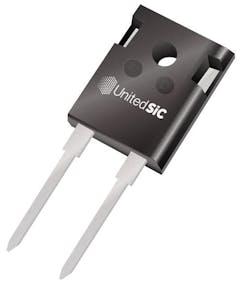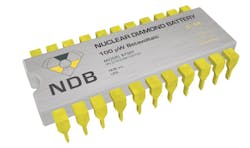>> Electronic Design Resources
.. >> Library: Article Series
.. .. >> Article Series: PowerBites
Smart Capacitor Switch Reduces Volume of AC-DC Converters by Up to 40%
The MinE-CAP IC recently introduced by Power Integrations dramatically reduces the size of universal input ac-dc converters by enabling the use of different bulk capacitors for low- and high-voltage operation. By limiting the size of the high-voltage bulk electrolytic capacitors required in offline power supplies, this new type of IC makes it possible to reduce adapter size by up to 40%.
The MinE-CAP device also significantly lowers in-rush current, making NTC thermistors unnecessary, and thus increasing system efficiency and reducing heat dissipation. The combined space savings helps designers create compact, easy-to-carry, high-wattage power adapters for smartphones, tablets, and other mobile devices.
The IC leverages the small size and low RDS(on) of gallium-nitride transistors to actively and automatically connect and disconnect segments of the bulk capacitor network, depending on ac-line voltage conditions. Designers using MinE-CAP can select the smallest high-line-rated bulk capacitor required for high ac-line voltages and allocate most of the energy storage to lower-voltage capacitors that are protected by the MinE-CAP until needed at low ac line. This approach dramatically shrinks the size of input bulk capacitors without compromising output ripple, operating efficiency, or requiring redesign of the transformer.
Housed in the miniature MinSOP-16A package, the new devices work seamlessly with Power Integrations’ InnoSwitch family of power-supply ICs with minimal external components. Two initial design example reports (DERs) show how the MinE-CAP IC can be used with InnoSwitch3-Pro PowiGaN devices to create a 65-W USB PD 3.0 power supply with 3.3- to 21-V PPS output for mobile phone/laptop chargers, and a 60-W USB PD 3.0 power supply for USB PD/PPS power adapters (shown in figure at the top of this story).
MinE-CAP MIN1072M ICs, available immediately, are priced at $1.75 for 10 Ku. Learn more about the family and download the reference designs at Power Integrations’ website: https://www.power.com/products/MinE-CAP.
Rugged 1200- and, Yes, 1700-V SiC Schottky Diodes
UnitedSiC announced four new UJ3D 1200- and 1700-V junction barrier Schottky (JBS) diodes to complement its FET and JFET transistor products. They’re the latest additions to the company’s third generation of silicon-carbide (SiC) merged-PiN-Schottky (MPS) diodes. Possessing a VF × Qc figure of merit (FOM) that’s at least 12% to 15% better than the competition, according to the company, these SiC JSB diodes are highly optimized for power-system designs requiring high efficiency and ultra-fast switching speeds. Anticipated applications include fast-charge electric-vehicle (EV) charging access points, industrial motor drives, and solar-energy inverters
The devices have a >8.8-mm clearance between the anode and the cathode, which makes them better at coping with noisy, poorly regulated electrical conditions where voltage transients are likely to be present. In high-current situations, their novel PN junction structure enables the injection of additional charge carriers. These features provide enhanced robustness, allowing the diodes to withstand much higher surge currents than competing devices (up to 12X the rated current).
The additions to the portfolio include a 1700-V, 25A-rated device and three 1200-V devices in 10-, 20-, and 50-A-rated options. Fully compliant with the AEC-Q101 automotive standard, all SiC diodes come in a compact TO247-2L package format and in die form. The UJ3D1725K2 1000-up resale price is $6.47. The UJ3D1210K2, UJ3D1220K2 and UJ3D1250K2 1000-up resale prices are $2.24, $3.39, and $9.55 respectively. Visit www.unitedsic.com for more information.The 15 new digital multiphase controllers are available now in 4- × 4-mm to 8- × 8-mm QFN packages from Renesas’ worldwide distributors. For more information, visit www.renesas.com/digital-multiphase-controllers.
The six new smart power stages are available now in 4- × 5-mm to 5- × 6mm QFN packages from Renesas’ worldwide distributors. For more information, visit www.renesas.com/smart-power-stage.
1200-V SiC MOSFET Offers Significantly Lower Losses
Toshiba Electronics Europe launched a 1200-V silicon-carbide (SiC) MOSFET that improves efficiencies and enhances reliability for high-power industrial applications including 400-V ac input ac-dc power supplies, photovoltaic (PV) inverters, and bidirectional dc-dc converters for uninterruptible power supplies (UPS).
Fabricated with Toshiba’s second-generation SiC chip design1, the TW070J120B power MOSFET's high-voltage resistance, high-speed switching, and low on-resistance characteristics help reduce power consumption and improve power density. In addition, the TW070J120B realizes low input capacitance (CISS) of 1680 pF (typ.), a low gate-input charge (Qg) of 67 nC (typ.), and an RDS(ON) of just 70 mΩ (typ.). When compared with a 1200-V silicon IGBT, such as Toshiba’s GT40QR21, the new device reduces turn-off switching loss by approximately 80% and switching time by around 70%, while delivering low on-voltage characteristics with a drain current (ID) of up to 20 A. The gate threshold voltage (Vth) is set high (in the range 4.2 to 5.8 V), which reduces the possibility of unintended or spurious turn-on (or off). Furthermore, the device's integrated SiC Schottky barrier diode with a low forward voltage (─1.35 V typical) also helps to reduce losses. Housed in a TO-3P(N) package, the TW070J120B MOSFET is available now. Additional information is available by clicking here. Reference:
1. Toshiba news release on July 30, 2020: “Toshiba’s New Device Structure Improves SiC MOSFET Reliability.”
Application-Specific FETs Tailored to Deliver Optimal Performance
Nexperia has created a new category of MOSFETs, known as application-specific FETs (ASFETs), which feature electrical parameters suited for specific applications. Nexperia's first families of ASFETs address applications including battery isolation, motor control, hot-swap, and Power over Ethernet (PoE). The improvements offered by these tailored ASFETs varies by the application. For hot-swap applications, they provide a 3X to 5X improvement in safe operating area (SOA). The devices created for motor applications offer maximum current ratings in excess of 300 A.
The ASFET category will be further enhanced with the imminent release of a new family of automotive products with guaranteed repetitive avalanche performance for driving inductive loads. Additional details are available at https://efficiencywins.nexperia.com/efficient-products/optimizing-mosfets-to-fit-specific-applications.html.
Nuclear Diamond Batteries Looking More Like Fiction Than Fact
Occasionally, we will run into a story about a "revolutionary" technology that's too good to be true, but too intriguing to ignore. That was the case with the long-lived batteries supposedly made from radioactive diamonds that we covered in the October 22, 2020 edition of PowerBites.
I was fascinated but skeptical about the company's claims, so I asked Peter Meyers, a friend of mine who teaches physics at Princeton University, for a reality check. Since he builds dark matter detectors in his spare time (I'm not making this up!), I figured he'd be able to figure out if there was any basis for the company's claims. Meanwhile, the story triggered the BS detector of at least one sharp-eyed reader named Erik Magnuson, who took the time to share his back-of-the-napkin analysis with me. He wrote:
I did a rough calculation on the amount of power to be expected from Carbon 14 decay in graphite used for moderators in nuclear reactors. I got about 100nW (-70dBW) per gram of carbon*. This is the total decay energy, of which a good fraction escapes with the neutrinos and not the expected electrical energy.
Sounds like BS to me.
*Assumptions; Neutron flux 10^14 n/cm^2-sec irradiation time 30 years.
Interestingly, Peter used the same adjective to describe the alleged capabilities of the device, after providing some slightly more detailed calculations indicating it could take up to 20 tons of retired moderator carbon to produce a few milliwatts worth of power. I'm in the process of translating Peter's analysis into plain English for a longer follow-up article while I attempt to get someone from Nuclear Diamond Batteries to return my calls for comment. Stay tuned!
>> Electronic Design Resources
.. >> Library: Article Series
.. .. >> Article Series: PowerBites





